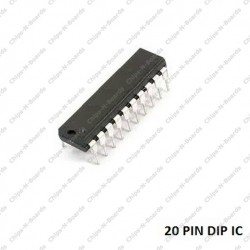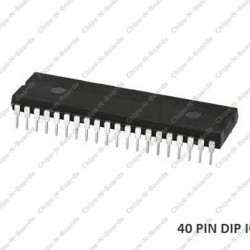Intel,Atmel 8051 Family

In 1981, Intel Corporation introduced an 8-bit microcontroller called the 8051. This microcontroller had 128 bytes of RAM, 4K bytes of on-chip ROM, two timers, one serial port, and four ports (each 8-bits wide) all on a single chip. At the time it was also referred to as a “system on a chip.” The 8051 is an 8-bit processor, meaning that the CPU can work on only 8 bits of data at a time. Data larger than 8 bits has to be broken into 8-bit pieces to be processed by the CPU. The 8051 has a total of four I/O ports, each 8 bits wide.
The Atmel Corp. has a wide selection of 8051 chips, as shown in Tables 1-6 and 1-7. For example, the AT89C51 is a popular and inexpensive chip used in many small projects. It has 4K bytes of flash ROM. Notice the AT89C51-12PC, where “C” before the 51 stands for CMOS, which has a low power consumption, “12″ indicates 12 MHz, “P” is for plastic DIP package, “C” is for commercial.
Model: TPS-00312
FeaturesCompatible with MCS®51 Products2K Bytes of In-System Programmable (ISP) Flash Program MemorySerial Interface for Program DownloadingEndurance: 10,000 Write/Erase Cycles2.7V to 5.5V Operating RangeFully Static Operation: 0 Hz to 24 MHz (x1 and x2 Modes)Two-level Program Memory Lock256 x 8-bit..
₹50.00
Model: TPS-00313 (HSN CODE 8542)
FeaturesCompatible with MCS®51 Products4K Bytes of In-System Programmable (ISP) Flash Program MemorySerial Interface for Program DownloadingEndurance: 10,000 Write/Erase Cycles2.7V to 5.5V Operating RangeFully Static Operation: 0 Hz to 24 MHz (x1 and x2 Modes)Two-level Program Memory Lock256 x 8-bit..
₹60.00
Model: TPS-00314 (HSN CODE 8542)
Features
Compatible
with MCS-51™ Products4K
Bytes of In-System Reprogrammable Flash MemoryEndurance:
1,000 Write/Erase CyclesFully
Static Operation: 0 Hz to 24 MHzThree-level
Program Memory Lock128
x 8-bit Internal RAM32
Programmable I/O LinesTwo
16..
₹135.00
Model: TPS-00315 (HSN CODE 8542)
Features• Compatible with MCS-51™ Products• 8K Bytes of In-System Reprogrammable Flash Memory• Endurance: 1,000 Write/Erase Cycles• Fully Static Operation: 0 Hz to 24 MHz• Three-level Program Memory Lock• 256 x 8-bit Internal RAM• 32 Programmable I/O Lines• Three 16-bit Timer/Counters• Eight Interru..
₹115.00
Model: TPS-00317 (HSN CODE 8542)
Features• Compatible with MCS®-51 Products• 8K Bytes of In-System Programmable (ISP) Flash Memory– Endurance: 10,000 Write/Erase Cycles• 4.0V to 5.5V Operating Range• Fully Static Operation: 0 Hz to 33 MHz• Three-level Program Memory Lock• 256 x 8-bit Internal RAM• 32 Programmable I/O Lines• Three 1..
₹80.00
Model: TPS-00316 (HSN CODE 8542)
Features• Compatible with MCS®-51 Products• 4K Bytes of In-System Programmable (ISP) Flash Memory– Endurance: 10,000 Write/Erase Cycles• 4.0V to 5.5V Operating Range• Fully Static Operation: 0 Hz to 33 MHz• Three-level Program Memory Lock• 128 x 8-bit Internal RAM• 32 Programmable I/O Lines• Two 16-..
₹80.00
Showing 1 to 6 of 6 (1 Pages)






